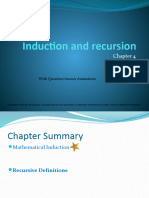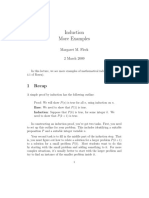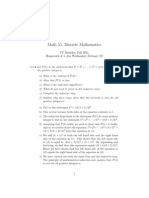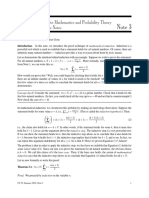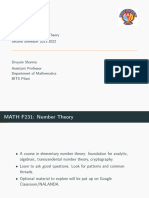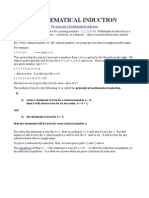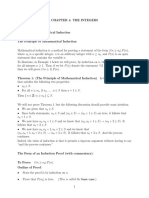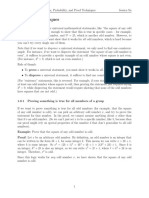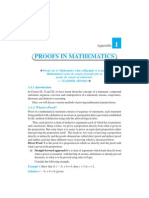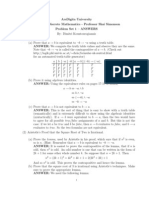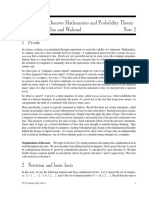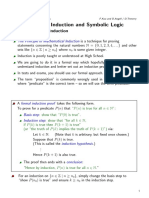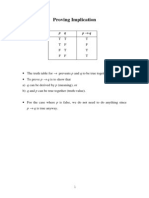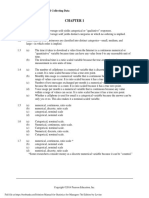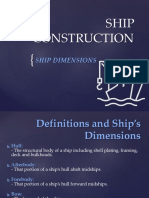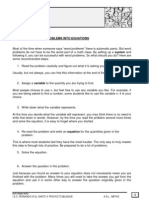Strong Induction: 1 A Geometrical Example
Strong Induction: 1 A Geometrical Example
Uploaded by
georgiandjimmyCopyright:
Available Formats
Strong Induction: 1 A Geometrical Example
Strong Induction: 1 A Geometrical Example
Uploaded by
georgiandjimmyOriginal Title
Copyright
Available Formats
Share this document
Did you find this document useful?
Is this content inappropriate?
Copyright:
Available Formats
Strong Induction: 1 A Geometrical Example
Strong Induction: 1 A Geometrical Example
Uploaded by
georgiandjimmyCopyright:
Available Formats
Strong induction
Margaret M. Fleck 4 March 2009
This lecture presents proofs by strong induction, a slight variant on normal mathematical induction.
A geometrical example
As a warm-up, lets see another example of the basic induction outline, this time on a geometrical application. Tiling some area of space with a certain type of puzzle piece means that you t the puzzle pieces onto that area of space exactly, with no overlaps or missing areas. A right triomino is a 2-by-2 square minus one of the four squares. (See pictures in Rosen pp. 277-278.) I then claim that Claim 1 For any positive integer n, a 2n 2n checkerboard with any one square removed can be tiled using right triominoes. Proof: by induction on n. Base: Suppose n = 1. Then our 2n 2n checkerboard with one square remove is exactly one right triomino. Induction: Suppose that the claim is true for some integer k. That is a 2k 2k checkerboard with any one square removed can be tiled using right triominoes. Suppose we have a 2k+1 2k+1 checkerboard C with any one square removed. We can divide C into four 2k 2k sub-checkerboards 1
P , Q, R, and S. One of these sub-checkerboards is already missing a square. Suppose without loss of generality that this one is S. Place a single right triomino in the middle of C so it covers one square on each of P , Q, and R. Now look at the areas remaining to be covered. In each of the sub-checkerboards, exactly one square is missing (S) or already covered (P , Q, and R). So, by our inductive hypothesis, each of these sub-checkerboards minus one square can be tiled with right triominoes. Combining these four tilings with the triomino we put in the middle, we get a tiling for the whole of the larger checkerboard C. This is what we needed to construct.
Strong induction
The inductive proofs youve seen so far have had the following outline: Proof: We will show P (n) is true for all n, using induction on n. Base: We need to show that P (1) is true. Induction: Suppose that P (k) is true, for some integer k. We need to show that P (k + 1) is true. Think about building facts incrementally up from the base case to P (k). Induction proves P (k) by rst proving P (i) for every i from 1 up through k 1. So, by the time weve proved P (k), weve also proved all these other statements. For some proofs, its very helpful to use the fact that P is true for all these smaller values, in addition to the fact that its true for k. This method is called strong induction. A proof by strong induction looks like this: Proof: We will show P (n) is true for all n, using induction on n. Base: We need to show that P (1) is true. Induction: Suppose that P (1) up through P (k) are all true, for some integer k. We need to show that P (k + 1) is true. 2
The only new feature about this proof is that, supercially, we are assuming slightly more in the hypothesis of the inductive step. The dierence is actually only supercial, and the two proof techniques are equivalent. However, this dierence does make some proofs much easier to write.
Postage example
Strong induction is useful when the result for n = k 1 depends on the result for some smaller value of n, but its not the immediately previous value (k). Heres a classic example: Claim 2 Every amount of postage that is at least 12 cents can be made from 4-cent and 5-cent stamps. For example, 12 cents uses three 4-cent stamps. 13 cents of postage uses two 4-cent stamps plus a 5-cent stamp. 14 uses one 4-cent stamp plus two 5-cent stamps. If you experiment with small values, you quickly realize that the formula for making k cents of postage depends on the one for making k 4 cents of postage. That is, you take the stamps for k 4 cents and add another 4-cent stamp. We can make this into an inductive proof as follows: Proof: by induction on the amount of postage. Base: If the postage is 12 cents, we can make it with three 4-cent stamps. If the postage is 13 cents, we can make it with two 4-cent stamps. plus a 5-cent stamp. If it is 14, we use one 4-cent stamp plus two 5-cent stamps. If it is 15, we use three 5-cent stamps. Induction: Suppose that we have show how to construct postage for every value from 12 up through k. We need to show how to construct k + 1 cents of postage. Since weve alread proved base cases up through 15 cents, well assume that k + 1 16. Since k +1 16, (k +1)4 12. So by the inductive hypothesis, we can construct postage for (k + 1) 4 cents using m 4-cent stamps and n 5-cent stamps, for some natural numbers m and n. In other words (k + 1) 4) = 4m + 5n. 3
But then k + 1 = 4(m + 1) + 5n. So we can construct k + 1 cents of postage using m + 1 4-cent stamps and n 5-cent stamps, which is what we needed to show. Notice that we needed to directly prove four base cases, since we needed to reach back four integers in our inductive step. Its not always obvious how many base cases are needed until you work out the details of your inductive step.
Nim
In the parlour game Nim, there are two players and two piles of matches. At each turn, a player removes some (non-zero) number of matches from one of the piles. The player who removes the last match wins.1 Claim 3 If the two piles contain the same number of matches at the start of the game, then the second player can always win. Heres a winning strategy for the second player. Suppose your opponent removes m matches from one pile. You remove m matches from the other pile. Lets prove that this strategy works. Proof by induction on the number of matches (n) in each pile. Base: If both piles contain 1 match, the rst player has only one possible move: remove the last match from one pile. The second player can then remove the last match from the other pile and thereby win. Induction: Suppose that the second player can win any game that starts with two piles of n matches, where n is any value from 1 through k. We need to show that this is true if n = k + 1. So, suppose that both piles contain k + 1 matches. A legal move by the rst player involves removing j matches from one pile,
1
Or, in some variations, loses. There seem to be several variations of this game.
where 0 j k + 1. The piles then contain k + 1 matches and k + 1 j matches. The second player can now remove j matches from the other pile. This leaves us with two piles of k+1j matches. If j = k+1, then the second player wins. If j < k + 1, then were now eectively at the start of a game with k + 1 j matches in each pile. Since 1 k + 1 j k, we know by the induction hypothesis that the second player can win the game. The induction step in this proof uses the fact that our claim P (n) is true for a smaller value of n. But since we cant control how many matches the rst player removes, we dont know how far back we have look in the sequence of earlier results P (1) . . . P (k). Our previous proof about postage can be rewritten so as to avoid strong induction. Its less clear how to rewrite proofs like this Nim example.
Prime factorization
The Fundamental Theorem of Arithmetic from lecture 8 (section 3.4) states that every positive integer n, n 2, can be expressed as the product of one or more prime numbers. Lets prove that this is true. Recall that a number n is prime if its only positive factors are one and n. n is composite if its not prime. Since a factor of a number must be no larger than the number itself, this means that a composite number n always has a factor larger than 1 but smaller than n. This, in turn, means that we can write n as ab, where a and b are both larger than 1 but smaller than n.2 Proof by induction on n. Base: 2 can be written as the product of a single prime number, 2. Induction: Suppose that every integer between 2 and k can be written as the product of one or more primes. We need to show
2
Well leave the details of proving this as an exercise for the reader.
that k + 1 can be written as a product of primes. There are two cases: Case 1: k + 1 is prime. Then it is the product of one prime, i.e. itself. Case 2: k +1 is composite. Then k +1 can be written as ab, where a and b are integers such that 1 < a, b < k + 1. By the induction hypothesis, a can be written as a product of primes p1 p2 . . . pi and b can be written as a product of primes q1 q2 . . . qj . So then k + 1 can be written as the product of primes p1 p2 . . . pi q1 q2 . . . qj . In both cases k + 1 can be written as a product of primes, which is what we needed to show. Again, the inductive step needed to reach back some number of steps in our sequence of results, but we couldnt control how far back we needed to go.
You might also like
- PDF Long Shadows David Baldacci downloadDocument47 pagesPDF Long Shadows David Baldacci downloadshackdayancNo ratings yet
- Lesson Plan in K-12 Bread and Pastry ProductionDocument8 pagesLesson Plan in K-12 Bread and Pastry ProductionGalvez ChaCha96% (269)
- Induction and Recursion: With Question/Answer AnimationsDocument74 pagesInduction and Recursion: With Question/Answer AnimationsRaduNo ratings yet
- Mathematical Foundations of Computer Science Lecture OutlineDocument4 pagesMathematical Foundations of Computer Science Lecture OutlineChenyang FangNo ratings yet
- Unit 3 Part 2Document79 pagesUnit 3 Part 2jakkidvarunreddy62No ratings yet
- Logic and Proofs - 5Document16 pagesLogic and Proofs - 5ozcan8479No ratings yet
- Induction and Recursion: With Question/Answer AnimationsDocument20 pagesInduction and Recursion: With Question/Answer AnimationsABU SUFIAN SHANTONo ratings yet
- Chap4 Sec1Document23 pagesChap4 Sec1An DoNo ratings yet
- Noether Chapter 8 OnlyDocument7 pagesNoether Chapter 8 OnlynicklaslizipaiNo ratings yet
- Math Notes On InductionDocument7 pagesMath Notes On Inductionseyfadinabdela42No ratings yet
- Discret MathDocument8 pagesDiscret MathHoja Christian BogdanNo ratings yet
- Chapter 5Document38 pagesChapter 5Sultan mohammad AziziNo ratings yet
- Chapter 5Document17 pagesChapter 5Irfan Fazail100% (1)
- Induction For MathDocument12 pagesInduction For MathMufita Nur AiniNo ratings yet
- College Algebra: Fifth EditionDocument48 pagesCollege Algebra: Fifth Editionnandarizqiapradana100% (1)
- Lectuer 6Document27 pagesLectuer 6Delicious Cooking StudioNo ratings yet
- Ch3 2 Proof Techniques Part2 2019Document40 pagesCh3 2 Proof Techniques Part2 2019pilotbairexdNo ratings yet
- DS-Lecture 07Document89 pagesDS-Lecture 07moazbinzafar2No ratings yet
- Math InductionDocument11 pagesMath Inductionمصطفى عمرانNo ratings yet
- CS 70 Discrete Mathematics and Probability Theory Spring 2016 Rao and Walrand Note 3 1 Mathematical InductionDocument11 pagesCS 70 Discrete Mathematics and Probability Theory Spring 2016 Rao and Walrand Note 3 1 Mathematical InductionAyesha NayyerNo ratings yet
- EECS70 Note 3Document11 pagesEECS70 Note 3adrianwei404No ratings yet
- Induction II: 1 AnnouncementsDocument8 pagesInduction II: 1 Announcementsguru_changkyuNo ratings yet
- Mathematical InductionDocument46 pagesMathematical InductionEvelyn Maligaya100% (2)
- Lecture Notes 1 Strong InductionDocument7 pagesLecture Notes 1 Strong InductionElliotNo ratings yet
- 3 InductionDocument11 pages3 InductionzyseecsNo ratings yet
- Mathematical InductionDocument9 pagesMathematical InductionBomi KimNo ratings yet
- Tutorial 3Document3 pagesTutorial 3Utkarsh TiwariNo ratings yet
- Chapter 5Document25 pagesChapter 5busatiNo ratings yet
- Discrete Mathematics: MATH-161Document24 pagesDiscrete Mathematics: MATH-161abdullahimran1677No ratings yet
- LECTURE CHAPTER 2 NewDocument24 pagesLECTURE CHAPTER 2 NewImran Abdul RashidNo ratings yet
- Lesson 7 - Induction & RecursionDocument10 pagesLesson 7 - Induction & RecursionIsura VishwaNo ratings yet
- Chapter 5Document23 pagesChapter 5مهند شادي عيسى (ابعيسى)No ratings yet
- Lesson 4.3 Methods of ProofDocument5 pagesLesson 4.3 Methods of ProofMarc Angelo TaguilingNo ratings yet
- CS246 Proof ProbabilityDocument13 pagesCS246 Proof ProbabilitysatmaniaNo ratings yet
- Merged SlidesDocument643 pagesMerged SlidesKHUSHI GUPTANo ratings yet
- The Principle of Mathematical InductionDocument6 pagesThe Principle of Mathematical InductionLiezel LopegaNo ratings yet
- Chapter 4: The Integers: N N N NDocument22 pagesChapter 4: The Integers: N N N NPiNo ratings yet
- cs70-2 Notes3 PDFDocument10 pagescs70-2 Notes3 PDFhuayongliNo ratings yet
- Proof TechniquesDocument19 pagesProof TechniquesBut Nobody CameNo ratings yet
- Sequences, Mathematical Induction, and Recursion Sequences, Mathematical Induction, and RecursionDocument49 pagesSequences, Mathematical Induction, and Recursion Sequences, Mathematical Induction, and RecursionKeri-ann MillarNo ratings yet
- Appendix I NCERT 12 MATHSDocument9 pagesAppendix I NCERT 12 MATHSAgam GoelNo ratings yet
- Chapter 5 - Mathematical ProofsDocument14 pagesChapter 5 - Mathematical ProofsTay Sunshine100% (1)
- Discrete Math ExercisesDocument6 pagesDiscrete Math ExercisesJennie Ron AblogNo ratings yet
- Sequences, Mathematical Induction, and Recursion: Alessandro Artale - Unibz - HTTP://WWW - Inf.Unibz - It/ ArtaleDocument27 pagesSequences, Mathematical Induction, and Recursion: Alessandro Artale - Unibz - HTTP://WWW - Inf.Unibz - It/ ArtaleDon Rayburn PilanNo ratings yet
- Problem Set 01 SolutionsDocument13 pagesProblem Set 01 SolutionsJaph DeeNo ratings yet
- CS 70 Discrete Mathematics and Probability Theory Spring 2016 Rao and Walrand Note 2 1 ProofsDocument8 pagesCS 70 Discrete Mathematics and Probability Theory Spring 2016 Rao and Walrand Note 2 1 ProofsAyesha NayyerNo ratings yet
- Lec08-Induction and RecursionDocument23 pagesLec08-Induction and Recursionyusufyemez1907No ratings yet
- Induction 2Document12 pagesInduction 2Smpnsatubontang KaltimNo ratings yet
- 2 ProofDocument9 pages2 ProofzyseecsNo ratings yet
- 2017 PuigDocument22 pages2017 PuigAhsen KamalNo ratings yet
- Topic3.2 3 LectureNotesDocument42 pagesTopic3.2 3 LectureNotesBenjamin LeungNo ratings yet
- Proving Implication: T T T F F T F F T F T TDocument10 pagesProving Implication: T T T F F T F F T F T Ttheresa.painterNo ratings yet
- Math 103 - Proof MethodsDocument4 pagesMath 103 - Proof Methodsビゲイル マリアアNo ratings yet
- Discrete Math PMIDocument2 pagesDiscrete Math PMIAashish SrinivasNo ratings yet
- Proofs Automata-IIDocument5 pagesProofs Automata-IIMuhammad Zahid RasheedNo ratings yet
- A Party Trick Featuring The Triangular NumbersDocument3 pagesA Party Trick Featuring The Triangular Numbersshailesh_shiral6022No ratings yet
- Mathematical Foundations of Information TheoryFrom EverandMathematical Foundations of Information TheoryRating: 3.5 out of 5 stars3.5/5 (9)
- Solution Manual For Statistics For Managers 7th Edition by Levine PDFDocument6 pagesSolution Manual For Statistics For Managers 7th Edition by Levine PDFa742435638No ratings yet
- Fanar & Rotana All-Inclusive Concept 2024 - A4Document14 pagesFanar & Rotana All-Inclusive Concept 2024 - A42pznvpgr8yNo ratings yet
- Analytic Rubric - Oral PresentationDocument1 pageAnalytic Rubric - Oral PresentationNICOLLE MONTIFALCONNo ratings yet
- 3BUA000279R0002 en Bridge Controller and Process Bus Adapter (BRC-400 and BRC-300 PBA-200) PDFDocument123 pages3BUA000279R0002 en Bridge Controller and Process Bus Adapter (BRC-400 and BRC-300 PBA-200) PDFJavier Enrique Contreras SierraNo ratings yet
- Scanlay1 Specifications - New PDFDocument3 pagesScanlay1 Specifications - New PDFPrathamesh OmtechNo ratings yet
- Ch01 Chemistry and The Atomic Molecular View of MatterDocument64 pagesCh01 Chemistry and The Atomic Molecular View of MatterSiti YusrianiNo ratings yet
- (Week 2) Ship ConstructionDocument42 pages(Week 2) Ship ConstructionJansen DolleteNo ratings yet
- Erik PrasetyoDocument136 pagesErik PrasetyoNabhan PuteraNo ratings yet
- GOMs 119 862021Document4 pagesGOMs 119 862021TomJohnNo ratings yet
- ISMS Implementation Training Exam PaperDocument14 pagesISMS Implementation Training Exam PaperTrivesh SharmaNo ratings yet
- P6006HV Niko-Sem: Dual N-Channel Enhancement Mode Field Effect TransistorDocument6 pagesP6006HV Niko-Sem: Dual N-Channel Enhancement Mode Field Effect TransistorfaberjetNo ratings yet
- Arp, DHCP, IcmpDocument32 pagesArp, DHCP, IcmpPrathibaaNo ratings yet
- Avani RiversideDocument10 pagesAvani RiversideDeepadharNo ratings yet
- Biofertilizer - WikipediaDocument24 pagesBiofertilizer - Wikipedia30521u33009No ratings yet
- 1.2P - Object Oriented Hello WorldDocument12 pages1.2P - Object Oriented Hello Worldertugrulzaman9No ratings yet
- Practical Guidelines For The Fabrication of Duplex Stainless Steels (2nd Edition)Document64 pagesPractical Guidelines For The Fabrication of Duplex Stainless Steels (2nd Edition)sanketNo ratings yet
- GGSIPU Admission BrochureDocument214 pagesGGSIPU Admission BrochureKetan KumarNo ratings yet
- E00804 Commercial Building For MRCB Technical OfferDocument8 pagesE00804 Commercial Building For MRCB Technical OfferkirubaNo ratings yet
- SLC PDFDocument88 pagesSLC PDFazatarothNo ratings yet
- This Study Resource Was: College of EngineeringDocument4 pagesThis Study Resource Was: College of EngineeringErrell Victorio GonzalezNo ratings yet
- Ethics and Excellence in Cooperative SectorDocument8 pagesEthics and Excellence in Cooperative SectorRonnie Balleras PagalNo ratings yet
- Application of Minimum Curvature Method To Wellpath CalculationsDocument8 pagesApplication of Minimum Curvature Method To Wellpath CalculationsMile SikiricaNo ratings yet
- Load Management SystemDocument40 pagesLoad Management Systematul mishraNo ratings yet
- Translating Word Problems Into EquationsDocument3 pagesTranslating Word Problems Into EquationsmariacaballerocobosNo ratings yet
- Fire Piping Installation and FlushingDocument7 pagesFire Piping Installation and Flushingsunny_84tNo ratings yet
- Gerund InfinitivesDocument3 pagesGerund InfinitivesFari TakNo ratings yet
- Defining ManagementDocument2 pagesDefining Managementhilton dos amores comeNo ratings yet
- Cement Aggregate Concrete Durability LectureDocument33 pagesCement Aggregate Concrete Durability LectureManoj Kumar SinghNo ratings yet








